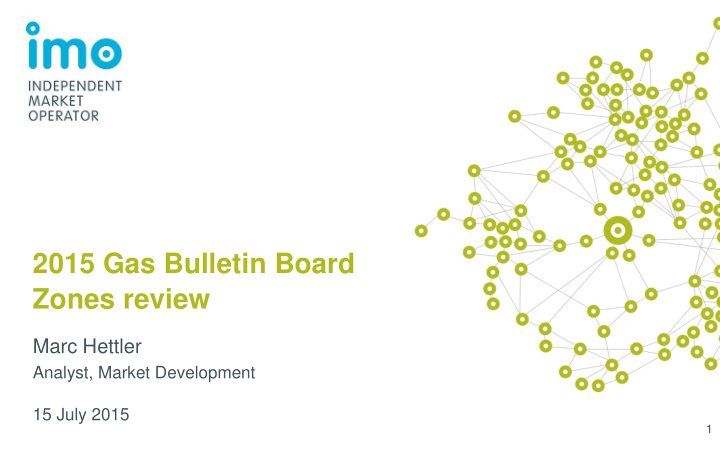



2015 Gas Bulletin Board Zones review Marc Hettler Analyst, Market Development 15 July 2015 1
Gas Bulletin Board Zones – general information Purpose of the Gas Bulletin Board (GBB) Zones: Provide transparent information of gas supply and demand across the state. Requirement to review the GBB Zones: In accordance with subrule 82(2) of the Gas Services Information (GSI) Rules, the IMO must review the GBB Zones at least once in each five year period or may do so at any point in time.
Decision to review the GBB Zones in 2015 Recently allocated the Fortescue River Gas Pipeline into the Pilbara Zone Fast track rule change to amend Schedule 2 of the GSI Rules Outlook: • Two more pipelines expected to commence operation in the next 12 months. • Review of the Zones could provide input for rule changes to reduce administrative burden and streamline the allocation process of new pipelines into GBB Zones or the creation of new GBB Zones. Further: Good opportunity to consult with gas industry participants and receive feedback on how the GBB data is used by participants. 3
Key milestones of the review Date Event 1 May 2015 Contract with Marsden Jacob Associates commenced 7 May - 14 May 2015 Informal pre-consultation period 2 June 2015 Publication of draft report 2 June - 30 June 2015 Submission period Mid July 2015 Publication of final report TBD Further steps 4
Draft Report recommendations Marsden Jacob Associates prepared the draft report which included six main recommendations. Administrative changes: • Remove the definition of the GBB Zones from the GSI Rules to give the IMO greater flexibility in amending the zones; • Division of the current Dampier Zone in a number of zones; • IMO adopt new Guidelines for allocation of new pipelines to GBB Zones; and • IMO adopt new Guidelines for future revisions of GBB Zones. Publication of information: • Publish nominations and forecasts for individual facilities; and • Capture large user facility data connected to non-GBB pipelines. 5
Submissions received Alinta APA Group Australian Petroleum Production & Exploration Association Citic Pacific Mining Management The Chamber of Minerals and Energy of Western Australia DBP Energy Supply Association of Australia Santos BHP Billiton (late submission) 6
Overview of submissions IMO received nine submissions following the publication of the draft report. General support for recommendations related to administrative changes Mixed support for recommendations related to the publication of information Issues raised: • Confidentiality of facility nominations and forecasts • Cost could outweigh benefit IMO will further consult with stakeholders to address issues. 7
Final Report recommendations Marsden Jacob Associates has prepared the final report which includes four main recommendations. Administrative changes: • Remove the definition of the GBB Zones from the GSI Rules and instead include it in a GSI Procedure; and • Adopt new Guidelines for the allocation of new pipelines to GBB Zones and any future revision of GBB Zones. Publication of information: • Publish nominations and forecasts for individual facilities; and • Capture large user facility data connected to non-GBB pipelines. 8
Questions 9
Further information 10
Recommendation 1 Remove the definition of the GBB Zones from the GSI Rules (Schedule 2) and instead include it in a GSI Procedure. Pros: • Less administrative burden to amend a GSI Procedure compared to GSI Rules • Still sufficient governance oversight and consultation with gas market participants Cons: • None identified 11
Recommendation 2 Publish nominations and forecasts for individual facilities. Pros: • Identify opportunities for gas trading between market participants • Improved visibility of Large User Facilities and Production Facilities will help resolve issues caused by unforeseen outages Cons: • Potential issues with confidentiality 12
Recommendation 3 Capture large user facility data connected to non-GBB pipelines. IMO’s current position is that this recommendation will not be adopted. The exemption requirements for Large User Facilities are addressed in Rule 47 Part 2 of the GSI Rules. 13
Recommendation 4 Adopt new guidelines for the allocation of new pipelines to GBB Zones and any future revision of GBB Zones. Pros: • New guidelines will reduce the regulatory process for GBB Zones’ administration • Will complement the revised governance arrangements suggested in recommendation 1 Cons: • Potential that guidelines could not be applied to edge cases 14
Recommendation 4 (cont.) Guidelines for the allocation of new pipelines to GBB Zones: If a gas pipeline has the following characteristics: • is located within a single economic region of Western Australia where gas production and/or consumption occurs e.g. Pilbara, Perth, South West; • is adjacent to an existing GBB Zone; • is connected directly to an existing GBB Pipeline; • has only gas production receipt points or only user delivery (outlet) points connected to the pipeline (not a mix of both) – implying that gas flows are typically one-way; then, allocate the pipeline to an existing GBB Zone. If not, consider creating a GBB Zone for the new pipeline or allocating the pipeline across multiple Zones (as is the case for the DBNGP and GGP). 15
Recommend
More recommend